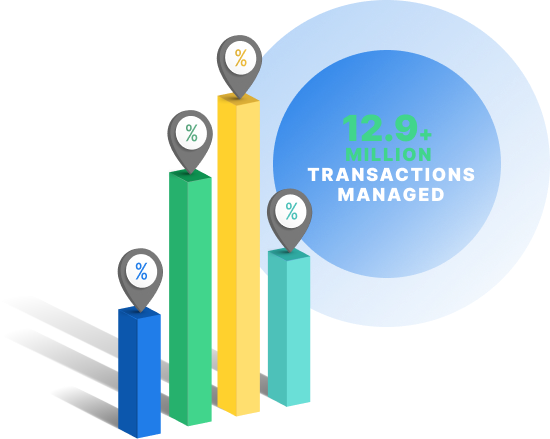What Is ROI in Marketing? Your Guide to Digital Marketing ROI
What is ROI in marketing?
ROI in marketing is the return you get from investing in marketing. When you calculate ROI for marketing, you attribute profit and revenue growth to marketing tactics to see how they contribute to your business’s growth.
The definition of ROI marketing focuses on measuring the performance of your marketing campaigns by calculating how much money you get in return from marketing your brand, products, or services online.
Key Takeaways
- Marketing ROI is the amount of profit you receive from your marketing campaigns and strategies.
- You can calculate your ROI in marketing using the simple formula: (Return – Investment)/ Investment
- A good marketing ROI is 5:1 — or $5 for every $1 spent.
- Tracking your ROI helps you understand what’s working, where to invest your budget, and how you stack up against your competitors.
- Some common challenges of measuring marketing ROI including tracking campaigns with multiple touchpoints, measuring it at the right time, and considering variations of influence
If you’re looking for an all-encompassing guide on marketing ROI, you’ve come to the right place.
On this page, we’ll cover topics like:
- What is ROI in marketing?
- How to calculate ROI in marketing?
- What is a good marketing ROI?
- Why measure marketing ROI?
- What makes measuring marketing ROI difficult?
You’ll get everything you need to know to help your online strategies thrive!
Keep reading to learn more about ROI in marketing and subscribe to Revenue Weekly for the latest tips and tricks on how to improve your ROI in marketing! Learn from our team of experts, who has driven over $6 billion in revenue for our clients, how to skyrocket your ROI!
Digital vs. Traditional Marketing
Download this guide to understand the key advantages, costs, and opportunities for each to decide which is best for your marketing strategy!
Get My Free Guide
What is ROI in marketing?
ROI in marketing is the return you get from investing in marketing. When you calculate ROI for marketing, you attribute profit and revenue growth to marketing tactics to see how they contribute to your business’s growth. You might also see it called marketing ROI (MROI) or return on marketing investment (ROMI).
How to calculate ROI in marketing
Now that we’ve answered, “What is ROI in marketing?” you’re probably wondering how to calculate ROI in marketing.
The simplest way is with this marketing ROI formula:
How to calculate marketing ROI: Simple calculation
(Return – Investment)/ Investment
While it’s a simple formula, it’s almost too simple.
For many marketers, it’s challenging to know what qualifies as an investment. Do you count salaries for marketing team members, for example, or only costs for hiring marketing freelancers or agencies?
Calculate your marketing ROI more effectively by following this marketing ROI formula:
Marketing ROI formula
[(Number of leads x Lead to customer rate x Average sale price) – Cost for marketing] / Cost for marketing
Okay, that’s a lot to take in and comprehend! Let’s break down each part of this formula:
- Number of leads: Your number of leads is how many people converted into a lead. These people have an established interest in your business.
- Lead to customer rate: Your lead to customer rate is how many people went from a lead to a customer. So, if you have 20 leads (out of 100 total leads) that became customers, your lead to customer rate is 20% or 0.2.
- Average sale price: Your average sale price is the average price of your product. Calculating the average allows you to account for sale prices and discounts.
- Cost for marketing: Your cost for marketing is the total amount you spend on your marketing campaign. This amount includes factors like ad spend, software, and wages for people who work on your campaign.
So, let’s say you have 1000 leads, and 50% of them become customers.
On average, they spend $200.
It cost you $4000 to market to these leads.
So, if we plug that into the formula, it looks like this:
ROI marketing calculation example
[(1000 x .50 x 200) – 4000] / 4000
[100,000 – 4000] / 4000
96,000 / 4000
24
Once you get your total, multiply it by 100 to get your ROI percentage. In this case, the ROI is 2400%.
What is a good marketing ROI?
So, we explaing the marketing ROI definition and explained how to use the marketing ROI formulas.
Now, you’re probably wondering, “What is a good marketing ROI?”
What is a good marketing ROI?
A good marketing ROI is 5:1 — or $5 for every $1 spent.
An outstanding ROI is 10:1, where you get $10 for every $1 spent.
That’s a simple answer, though.
A good ROI will depend on your business. It relies on factors like your company’s overhead costs, margins, and industry. For some industries, an ROI of 3:1 isn’t great, but it’s excellent for a business in a different sector.
Why measure marketing ROI?
Now that you know all the basics of ROI, you’re probably wondering why you should measure your marketing ROI.
Let’s look at three benefits of calculating your marketing ROI.
1. Calculating marketing ROI helps you see what’s working
When you calculate your marketing ROI, you can see what digital marketing strategies work for your business. It’s difficult to know if these tactics are working if you don’t measure how they help your company.
If you calculate your ROI for your digital marketing strategies, you can discover what’s driving sales.
This information can help you revamp campaigns to drive better results. It may not be the tactic itself, for example, but the ad copy or targeting causing your low ROI. Calculating your ROI will allow you to see what works, so you can make changes to drive better results.
2. Calculating marketing ROI helps you determine where to invest your budget
When you calculate your marketing ROI, you learn what strategies work and which ones don’t. This information helps you decide where to invest your budget.
So, for example, you may find that your social media advertising campaign has a 2:1 ROI, while your PPC campaign drives an 8:1 ROI. As a result, you realize that your social media ads aren’t working well for your ad strategy.
You can go one of two ways with this information.
One, you can shift your ad budget from social media advertising to PPC advertising. This strategy is standard, as most businesses stick to tactics that drive a consistent and impressive return.
Two, you can put more funds into strategies that aren’t driving the best ROI. You may choose to invest more of your budget into these underperforming strategies to help you optimize your campaigns and improve them.
The second option typically happens when companies don’t set a realistic ad spend, which sets them up for failure from the beginning. By adjusting your ad spend, you may invest enough to drive better results.
Overall, knowing your ROI enables you to get a full scope of what’s working in your marketing strategy, so you can determine how to rework your budget and get the best possible return from it.
Learn About Manufacturing Marketing ROI
3. Calculating marketing ROI helps you see how you stack up to the competition
When you measure your marketing ROI, you can use that information to gauge how you stack up to competitors. This information helps you understand how you perform in your industry.
Many companies will have a public release of financial data if they are a publicly-traded company. While it doesn’t state their marketing ROI outright, you can use this data to estimate your competitor’s ROI.
When you know this information, you can compare your business to your competition. It can help you revamp your strategy to drive better results with your marketing channels.
3 challenges with measuring marketing ROI
When you measure your marketing ROI, you’ll find that you’re going to face some difficulties with measuring it accurately. Let’s look at the top three challenges you’ll have when measuring ROI in marketing.
1. Multiple touchpoints
The biggest challenge you’ll meet with measuring your ROI in marketing is touchpoints.
The customer’s journey isn’t linear — every customer journey is different. People can interact with your business in multiple ways, which can sometimes make it difficult to know what piece of marketing caused a conversion.
Users can have multiple touchpoints — just look at this example of a customer’s potential journey:
- Discovers your brand through search
- Reads a blog post from your site
- Subscribes to your email list
- Watches a video about your product
- Sees a targeted ad on social media
- Buys your product
In this journey, it’s hard to know precisely what led the user to convert. While the targeted ad was the last step, it could have been the video that made them ready. There isn’t a clear-cut way to know which strategy made your audience convert.
Solution: Focus on the first and last touchpoints
A potential solution to this challenge is focusing on the first and last touchpoints for attribution. This model focuses on giving the ROI “credit” to the first and last touchpoints before the sale. While it’s not the only solution, it’s an option to help you measure your ROI accurately.
Additionally, investing in a CRM software, like Nutshell, can help you easily track these touchpoints to understand what makes users convert. The best part is you don’t have to spend hours investigating. Nutshell does all the hard work for you!
2. Measuring at the right time
Another challenge with how to measure marketing ROI is measuring at the right time.
Not every customer purchases in the same amount of time. While you probably have an average duration for your sales cycle, not everyone converts in the same amount of time. You may have people that make impulse purchases and convert fast, while others take longer.
Some customers may not be ready to buy or don’t need the product right away. They may purchase eventually, but your campaign may be over by the time they purchase.
Additionally, some strategies take longer than others to get conversions. For example, email marketing may take sending a couple of emails to get a conversion, while a PPC ad may generate a conversion with a single click.
It can make it challenging to attribute conversions to the right campaign.
As a result, you need to identify the right time to measure ROI.
Solution: Make revenue cycle projections
With this solution, you calculate the long-term effects of marketing strategies. You’ll use your history of metrics to make projections. Primarily, you’ll use past performance to predict which approach was most likely to generate the sale.
A CRM software can help you manage this data to help you make projections.
The downfall with this strategy is that it doesn’t factor in market changes or outside variables, so you’ll need to take these changes into account when trying to determine which strategies led to that conversion.
3. Influence level
Another factor you must consider is the variations of influence.
Not every campaign will resonate with your audience the same. Many people will see your ad and not feel compelled, while others will feel compelled to act.
When these people take action, it can skew your data and make it more challenging to measure your ROI accurately.
Solution: Analyze the impact of each touchpoint
A solution to this challenge is to work backward and look at each touchpoint to see how it impacted the customer. This strategy is most beneficial to companies with longer sales cycles because it helps them have a clearer picture of what steps influence customers the most.
If you use CRM software like Nutshell, you can track each touchpoint to give credit to strategies that have the most significant impact.
The downside with this tactic is that you may give more credit to a strategy than is due. It also doesn’t account for outside variables that might impact how people engage with specific tactics or channels, like email and social media.
Time to Level Up Your Sales
Our long list of services helps you grow every aspect of your business with marketing strategies that are proven to increase bottom-line metrics like revenue and conversions.
In the past 5 years, we’ve managed more than 14.9 MILLION transactions across our client base.

Let WebFX help you improve your digital marketing ROI
When you know how to calculate ROI in marketing, you can see if your campaigns drive the results you desire. If your campaign isn’t driving the best results, you may need to revamp your strategies to improve your ROI.
That’s where WebFX can help.
With over two decades of experience, we know how to drive results that improve your ROI.
When you partner with us, we treat you like family. That’s why 90% of WebFX clients continue partnering with us. You’ll get a long-term partner that will help improve your marketing ROI and grow your business online.
Ready to start improving your marketing ROI?
Give us a ring at 888-601-5359 or contact us online to speak with a strategist and learn about how our ROI dashboards help you keep track of your ROI!
Related Resources
- What is Predictive Marketing? (And Why Does It Matter Now?)
- What is Relationship Marketing?
- What is Revenue Marketing? the Complete 2024 Guide
- What is Revenue Operations and Why Do You Need It?
- What is Sales Collateral? 10 Real-Life Examples of Collateral for Sales
- What is SMB Marketing? 10 Effective Tactics to Skyrocket Your SMB Marketing
- What is SMS Compliance and How Can Your Business Follow It?
- What is the Product Life Cycle? Stages and Examples
- What is Time to Value (TTV) and How Do You Measure It?
- 3 Commonly Misunderstood Marketing Terms and What They Mean
Marketing Tips for Niche Industries
- Tourism/hospitality Statistics
- Treat More Patients with Healthcare Marketing Services
- Urgent Care Marketing Ideas: 5 High-ROI Tactics
- WebFX: Your Education Digital Marketing Agency
- Why Auto Part Retailers Need Digital Marketing
- Why Digital Marketing is Essential for Auctioneers
- Your Guide to Digital Marketing for Exercise Equipment Companies
- Vision Care Industry Statistics
- 10 Best Orthodontist Marketing Ideas to Earn More Patients
- 10 Digital Marketing Strategies for the Heavy Equipment Industry









